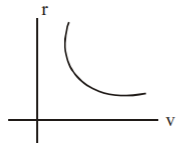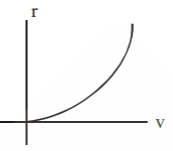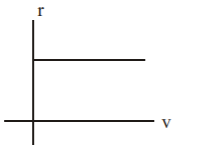a particle moving in a circle track is given potential energy U=−kr where U is potential energy and r is radius. The correct graph between speed and radius of particles will be




To solve the problem, we need to analyze the relationship between the speed of a particle moving in a circular track and its radius when the potential energy is given by U=−kr.
1. Understand the Potential Energy:
The potential energy of the particle is given as:
U=−kr
where k is a constant and r is the radius of the circular path.
2. Calculate the Force:
The force acting on the particle can be derived from the potential energy using the relation:
F=−dUdr
Calculating the derivative:
F=−ddr(−kr)=kr2
3. Centripetal Force Requirement:
For a particle moving in a circular path, the centripetal force required is given by:
Fc=mv2r
where m is the mass of the particle and v is its speed.
4. Set the Forces Equal:
Since the force derived from the potential energy must equal the centripetal force, we have:
mv2r=kr2
5. Rearranging the Equation:
Multiply both sides by r:
mv2=kr
Now, solve for v2:
v2=kmr
6. Express Speed in Terms of Radius:
Taking the square root gives us the expression for speed:
v=√km⋅1√r
This shows that speed v is inversely proportional to the square root of the radius r.
7. Graph Interpretation:
The relationship v∝1√r indicates that as the radius increases, the speed decreases. This relationship will produce a hyperbolic curve when plotted on a graph of speed v versus radius r.
Conclusion:
The correct graph between speed and radius of the particle will be a hyperbolic curve.
The potential energy of the particle is given as:
U=−kr
where k is a constant and r is the radius of the circular path.
The force acting on the particle can be derived from the potential energy using the relation:
F=−dUdr
Calculating the derivative:
F=−ddr(−kr)=kr2
For a particle moving in a circular path, the centripetal force required is given by:
Fc=mv2r
where m is the mass of the particle and v is its speed.
Since the force derived from the potential energy must equal the centripetal force, we have:
mv2r=kr2
Multiply both sides by r:
mv2=kr
Now, solve for v2:
v2=kmr
Taking the square root gives us the expression for speed:
v=√km⋅1√r
This shows that speed v is inversely proportional to the square root of the radius r.
The relationship v∝1√r indicates that as the radius increases, the speed decreases. This relationship will produce a hyperbolic curve when plotted on a graph of speed v versus radius r.
The correct graph between speed and radius of the particle will be a hyperbolic curve.
Topper's Solved these Questions
- JEE MAIN 2021BOOK - JEE MAINS PREVIOUS YEARCHAPTER - JEE MAIN 2021EXERCISE - SECTION-A
80 Videos
- JEE MAIN 2021BOOK - JEE MAINS PREVIOUS YEARCHAPTER - JEE MAIN 2021EXERCISE - SECTION-B
40 Videos
- JEE MAINBOOK - JEE MAINS PREVIOUS YEARCHAPTER - JEE MAINEXERCISE - All Questions
473 Videos
- JEE MAIN 2022BOOK - JEE MAINS PREVIOUS YEARCHAPTER - JEE MAIN 2022EXERCISE - Question
492 Videos
Similar Questions
A particle of mass m moves in a circular orbit under the central potential field, U(r)==−Cr, where C is a positive constant.
The correct radius -velocity graph of the particle's motion is.
View SolutionThe angular acceleration of a particle moving along a circle is given by a=ksin (theta),where "theta" is the angle turned by particle and k is constant.The centripetal acceleration of the particle in terms of k ,theta and R (radius of circle) is given by
View Solution
Knowledge Check
A particle is executing SHM. At a displacement y1 its potential energy is U1 and at a displacement y2 its potential energy is U2. The potential energy of the particle at displacement (y1+y2) is
AU1+U2B√U21+U22CU1−U2DU1+U2+2√U1U2A particle is moving in a circular path of radius a under the action of an attractive potential U=−k2r2. Its total energy is :
A−32ka2B−k4a2Ck2a2DZeroIf a particle of mass m is moving in a horizontal circle of radius r with a centripetal force (−1/r2) , the total energy is
A−4rB−2rC−1rD−12r
The potential energy of a particle moving in a circular path is given by U=U0r4 where r is radius of circular path. Assume bohr model to be valid. The radius of nth orbit is r∝n1α where α is
View SolutionThe potential energy of a particle of mass 2kg moving along the x-axis is given by U(x)=4x2−2x3( where U is in joules and x is in meters). The kinetic energy of the particle is maximum at
View SolutionA particle of mass m moves under the action of a central force. The potential energy function is given by U(r)=mkr3 Where k is a positive constant and r is distance of the particle from the centre of attraction. (a) What should be the kinetic energy of the particle so that it moves in a circle of radius a0 about the centre of attraction? (b) What is the period of this circualr motion ?
View SolutionThe kinetic energy K of a particle moving along a circle of radius R depends upon the distance S as K=βS2 , where β is a constant. Tangential acceleration of the particle is proportional to
View SolutionA small particle of mass m, moves in such a way that the potential energy U=ar3, where a is position constant and r is the distance of the particle from the origin. Assuming Rutherford's model of circular orbits, then relation between K.E and P.E of the particle is :
View Solution
